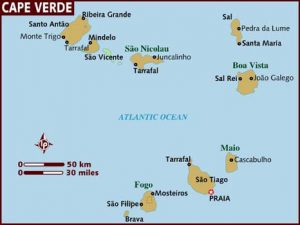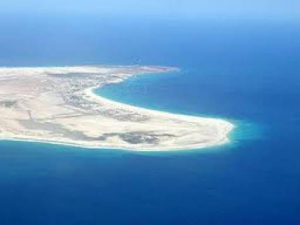by Ed Marks
The is first of two “Letters” from Praia, the capital of the former Portuguese colony of Cape Verde off the west coast of Africa. The author was accredited to the island nation while simultaneously Ambassador to Guinea-Bissau.–Ed.
 |
|
courtesy of LonleyPlanet.org
|
Next one is struck by the realization that except in a geographic sense Cape Verde is not an African country. It is a small, poor, Portuguese province, adrift off the coast of Africa. The Cape Verdean peasant may be no better educated nor in any sense richer that his counterpart on the coast of Africa, but he is not an African, he does not belong to the cultural and tribal culture which, with local variations, exists from one end of Africa to the other.
Cape Verde has a distinctive culture of its own; rich in music, literature, and a whole bag of cultural identification and memories. But this culture is clearly a regional or provincial version of the broader Portuguese culture and differs no more from the “norm” than the traditional provinces of the Metropole itself.
However, geography is determinant and Cape Verde as a political and economic nation-state has taken its place on the international scene as an African country. It talks African internationally, and has tied its economic future to West African regional economic organization. It is difficult to see how it could do otherwise.
There is another link to the African continent, which is peculiar to Cape Verde. Portuguese West Africa, now the Republic of Guinea-Bissau, has often been described as having been a Cape Verdean rather than a metropolitan colony. The administrative and commercial sectors of the colony were heavily staffed by Cape Verdeans who had obeyed the economic imperative of the islands to emigrate. It was from within this group that the independence movement arose, and the independence of both Guinea-Bissau and Cape Verde was won by an ethnic Cape Verdean rebellion fought on the mainland, but in the name of both countries.
 Cape Verde Flag
Cape Verde Flag
The present leadership in Guinea-Bissau is largely Cape Verdean in ethnic and cultural background and the single political party, which rules both countries, is formally committed to unification. This commitment appears increasingly illusory as time passes and, given the fundamental cultural differences between them not to mention practical problems relating to geographic distance and institutional inertia, always may have been an unrealistic dream.
In any case, independence has meant relatively little change in Cape Verde to date. Cape Verde — as a country, as a culture, as an identity — existed prior to independence. A large amount of foreign economic assistance has been forthcoming, but it probably does not at the moment exceed that amount of economic flow, which came from Portugal in the final years of the colonial period. To the average Cape Verdean life is unchanged as his status and personal sense of identity remained the same. This is not to say that the future does not forestall significant reform and the building of a new nation. Outside influences are beginning to play a role forbidden by the colonial regime and the international environment in which Cape Verde now lives is dramatically different.
Although isolated geographically and until recently politically and culturally, Cape Verde nevertheless also has a long tradition of family connections with the outside world. As mentioned previously, the islands’ traditional poverty — dating from at least the heyday of the slave trade — has created a national vocation for immigration. There are more Cap Verdean resident outside the islands than within. Dakar alone has a Cape Verdean community larger than that of the capital city of Praia. There are large communities in Portugal and Holland, not to mention the largest of all in the United States. There still remains a sizeable number of Cape Verdeans in Angola, although many have returned to Cape Verde or gone to Lisbon since Angolan independence. At any one time, about 800 Cape Verdeans work on Western European merchant ships, and a new immigrant community (largely of young girls) of more than 9,000 has grown in Rome as the Italians discovered the virtues and availability of Cape Verdean maids.
Most of these communities retain extremely close ties with the mother country. They were in fact an early version of Europe’s “guest worker” communities. Their regular remittance of funds to their families at home has always been a major source of the islands’ income.
The American community is somewhat different, as it has increasingly become a permanent emigration. The American Cape Verdeans originally came from the islands of Fogo and Brava and the latter island is becoming almost depopulated as the old tradition of returning to Cape Verde to live out one’s final days is dying out. Certainly independence and the passing of the old timers have contributed to this, but another factor has been the Americanization of the second and third generations. In any case, Brava in particular exudes a lonely atmosphere with its numerous deserted houses built by emigrants to the U.S for their old age, and now left empty.
The differing overseas emigration destinations of the various islands reflect the still significant regionalism, which is felt by residents of the different Cape Verde islands. Cape Verdeans identify themselves by their islands as much as anything else. There is even a local version of the New York — Washington competition. Although the capital of Praia is now almost as large as the major port of Mindelo on Sao Vicente Island, the evident prosperity and sophistication (comparative) of the latter creates a strong feeling of superiority on the part of the Mindelense. Mindelo was and still is the home of the old merchant and seafaring classes, and was the center of conservative opposition to the PAIGC and the idea of independence. The government still views Mindelo with some suspicion, particularly since the majority of the current leadership are themselves Mindelense. As the true capital of Cape Verde in the colonial days, even though Praia was the administrative center, it was there that the Cape Verdean elite was largely formed. Some of that elite became the leaders of the independence movement.
The “Portugueseness” of Cape Verde is also very evident in the operational style of the government. The preoccupation with official documents is prevalent. The oratorical style of the leadership is more so. President Pereira’s speech to the Third Party Congress in Bissau last November lasted over nine hours. Guinea-Bissau President Cabral’s speech to the Guinea-Bissau National Assembly topped that at ten and one-half hours. (He too is a Cape Verdean). Although the current national dress is a citified form of safari suit, Cape Verdean delegations boarding airplanes for Europe are resplendent in well-cut three-piece suits from Lisbon. (Having been burnt once or twice, Cape Verdean receptions committees meeting Senegalese delegations at the airport are now also well turned out in suits, white shirts, and dark ties).
There is an old saying that Portugal is a family not a country. This is even truer of Cape Verde, and the extended family includes the overseas communities. It sometimes seems that everyone has a relative in the U.S., from the President of the Republic to the Embassy chauffeur. Following Prime Minister Pires’ speech at Boston University last October every member of his delegation asked permission to go and see relatives. One of the Prime Minister’s closest advisors, a fairly radical young party type, walked up to the Prime Minister in his hotel room and, with a big grin on his face, asked permission to “go home for dinner.” His father lives in Boston.
There is a very active small town social life in Praia, but one from which foreigners are largely excluded. The new leadership is sufficiently Cap Verdean to follow the local tradition of extra-marital liaisons, and some of the most senior ministers have installed young ladies in their own or other houses.
The level of literacy is reasonably high by African standards, with an estimated 20 percent literacy rate. Although Cape Verdean women are kept in their place in the Latin tradition, there are in fact many quite sophisticated and well-educated women in the islands. Curiously, women — mostly Cape Verdean — play a larger and more prominent public and social role in Guinea-Bissau than in Cape Verde. This probably is merely another manifestation of Cape Verde’s essentially old-fashioned Portuguese cultural style.
The Government’s political attitudes are still very much in a formative stage. Most of the senior leadership, and certainly President Pereira, are essentially moderate men although wedded to the “progressive” world view of the Third World. There is a poorly defined younger group who are purportedly more radical, and the Minister of Defense Silvino da Luz is reported to be their standard bearer. We do not really know much yet about them, but da Luz himself is clearly oriented towards close ties with the Soviet Union.
Cape Verdeans in general as well as the Government in particular were clearly pleased by the opening of the American Embassy early last year. With only a moderate amount of pushing, the Government agreed to meet our desperate housing needs by building four new houses for our use. Designed by the one local architect, Lisbon-trained thirty years ago, the houses are a bit bizarre, but nevertheless they are now one of the sights of Praia. (We shall have to do something about masking them.)
In sum, Cape Verde is a rather unique little country. Although all former colonies present a facade dating from the former Metropolis (croissants in Brazzaville, steak and kidney pie in Lusaka), Cape Verde is a profoundly Portuguese little community — but Portuguese of a previous generation despite the fashionable political rhetoric.
|
|
|
Arial View
|
Surrounded by seawater, the islands are virtual desert and the Government has vague ambitions of fostering tourism and commercial fishing. The country in perspective is a mixture of centuries-long political and cultural isolation and an equally long tradition of humble working class emigration for work. It is European in background, but with traditions from a Europe which no longer exists. It is located in Africa and accepts the implication of this geography. And finally, its location makes it a potentially important strategic location for military use by a major power. All in all, it would seem the new Government of the old country of Cape Verde finds itself with a puzzling and difficult set of problems and concerns. As they are a nice people — tenacious, hard working, and serious — one can only wish them the best of luck.
Letter from Praia, 1979 follows in our next issue.![]()

Ed Marks served more than 40 years in the U. S. Foreign Service, including an assignment as ambassador to Guinea-Bissau and Cape Verde. He graduated from Michigan and Oklahoma universities and attended the National War College. Retiring in 1995, he subsequently served on detail to the U. S. Pacific Command. He is currently a Senior Fellow at the Joint Forces Staff College and a member of the American Diplomacy board.

